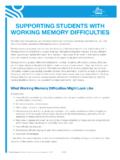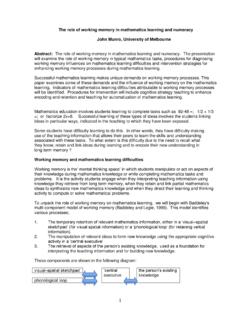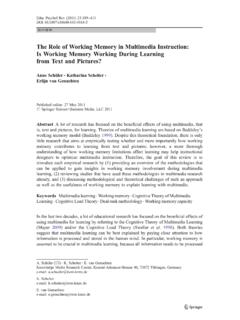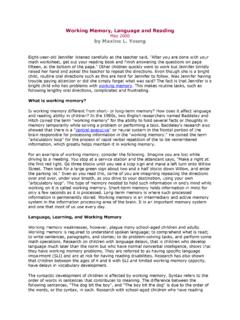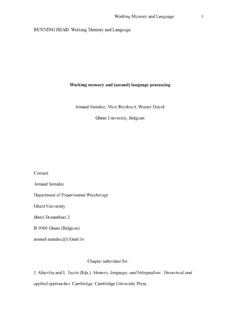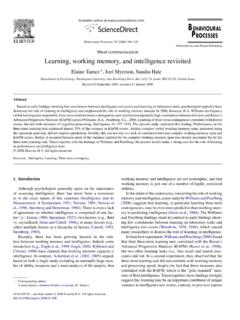Transcription of Working Memory Training and the Effect on Mathematical ...
1 Journal of Education and learning ; Vol. 2, No. 1; 2013 ISSN 1927-5250 E-ISSN 1927-5269 Published by Canadian Center of Science and Education 118 Working Memory Training and the Effect on Mathematical Achievement in Children with Attention Deficits and Special Needs Karin I. E. Dahlin1 1 Department of Special Education, Stockholm University, Stockholm, Sweden Correspondence: Karin Dahlin, Department of Special Education, Stockholm University, Stockholm, Sweden. Tel: 46-708-679-122. E-mail: Received: October 20, 2012 Accepted: November 8, 2012 Online Published: January 16, 2013 URL: Abstract Working Memory (WM) has a central role in learning . It is suggested to be malleable and is considered necessary for several aspects of Mathematical functioning. This study investigated whether work with an interactive computerised Working Memory Training programme at school could affect the Mathematical performance of young children.
2 Fifty-seven children with attention deficits participated in an intervention programme. The treatment group trained daily, for 30-40 min. at school for five weeks, while the control group did not get any extra Training . Looking at the group as a whole, Mathematical performance improved in the treatment group compared with the control group directly following the five weeks of Training (Time 2), but the results of the second post-test (Time 3, approximately seven months later) were no longer significant. Since there was only a small number of girls, the results were analysed for boys only. The boys had improved their Mathematical results in both post-tests. WM-measures improved at Time 2 and 3 relative to Time 1 (pre-test) for the whole group, and for boys. Differences in Training scores were related to differences in the non-verbal WM-measure Span board back. The results indicate that boys aged 9 to 12 with special needs may benefit, over time, from WM Training , as shown in the enhanced results in mathematics following WM Training .
3 However, as the intervention and control groups were not randomised, the results cannot be generalised; the results must be considered with caution. Keywords: Working Memory Training (WM Training ), attention, mathematics, special needs 1. Introduction Working Memory WM has a central role in learning and thinking and is conceptualised as the main cognitive system that stores and processes information. It is suggested that in order to remember information, it must first be processed in WM (Cowan, 2005). WM supports learning through the abilities to focus on the task in hand, inhibit irrelevant information and integrate information from several sources, including long-term Memory (LTM). WM ability governs how successful the learning will be, as it is involved in processes necessary for achieving automatised knowledge (Cowan, 2005; Dehn, 2008). Several theories describe the processing functions of WM. An embedded system is proposed by Cowan (2005), who states that attention control determines the outcome of cognitive processing.
4 Ericsson & Kintsch (1995) propose a system that includes processing in LTM as well as in WM whilst performing skilled activities. This suggested long-term WM (LT WM) makes it possible to expand the processing and storing of specific tasks in WM ( , remembering many digits). LT WM is, for example, used in various professions, including by waiters (remembering and updating orders), doctors (recalling knowledge and identifying the correct medical diagnosis) and chess players (planning the next moves and considering the consequences of these). The revised 1970s model presented by Baddeley & Hitch is often used in educational research. It consists of a central executive with three subsystems: the phonological loop, the visuo-spatial sketch pad and the episodic buffer (Baddeley, 2000). The central executive function (CEF), with its attention-control system, is considered the most complex component of WM.
5 It eliminates unimportant information, coordinates ongoing processes of information, and controls strategies and inhibition, one of the most important functions of the CEF (Dehn, 2008). In the phonological loop, sound and speech are stored for a few seconds. The loop includes a rehearsal Journal of Education and learning Vol. 2, No. 1; 2013 119 function, the articulatory loop, which prevents the information from decaying, supporting loop storage capacity and verbal processing (Baddeley, 2000). The visuo-spatial sketch pad holds visual and spatial information. The episodic buffer interfaces with LTM and the CEF in WM, and may also control the awareness of consciousness (Baddeley, 2000). Baddeley s model, with the central executive and the three subsystems, is useful when trying to explain learning outcomes in relation to WM as it is often used in educational research.
6 WM is considered one of several executive functions (cognitive processes, EFs). EFs are described in various ways. Barkley (1997) synthesised a model of EFs from several theories, proposing that four EFs, which are necessary for behavioural inhibition, affect the motor control ability. One such function is WM. The other three functions are self-regulation ( , emotional self-control and regulation of arousal), internalisation of speech and reconstitution ( , analysis of behaviour). Children with attention deficit hyperactivity disorder (ADHD) have, for example, been found to be more active, more talkative, to make more errors and to have problems with inhibition compared with children without ADHD (Barkley, 1997). WM and Attention Deficits/ADHD WM makes it possible to concentrate and inhibit inappropriate information (Cowan, 2005). Attention difficulties seem to be more associated with deficiencies in cognitive development and with low school performance than with problems of hyperactivity and impulse control.
7 Children with severe attention deficits, may be those who suffer significantly from visuo-spatial WM deficits (Castellanos & Tannock, 2002). Some of these children have ADHD. ADHD seems to be related to WM skills ( , Willcut, Doyle, Nigg, Faraone, & Pennington, 2005; Gropper & Tannock, 2009). However, children with ADHD are not a homogeneous group. Children with ADHD-I (inattention predominates) may sometimes be harder to identify than those with ADHD-C (ADHD-combined, attention and hyperactivity problems) and comorbidity may vitiate comparisons among children with ADHD, , anxiety, learning disabilities, below-average language skills, conduct disorder (CD) and oppositional defiant disorder (ODD) (Nigg, 2006). Gender differences in ADHD have also been found: , girls are less hyperactive and less impulsive. Moreover, more boys than girls are diagnosed with ADHD.
8 The proportion of boys and girls with attention deficits ranges from 3:1 to 9:1, resulting in fewer girls than boys being examined in empirical studies (Gershon, 2002). Gropper & Tannock (2009) found that university students with ADHD performed worse than the controls on one non-verbal measure, , the Spatial span back. On the other hand, they were impaired on three out of four verbal WM measures. Willcut et al. (2005) found several executive functions to be associated with ADHD, such as planning, inhibition, attention and spatial WM abilities, which may negatively influence social interactions and academic outcomes (Miller & Hinshaw, 2010). WM and Mathematics Academic outcomes such as mathematics seem to be linked to WM ( , Swanson, 2006). Some children show difficulties in developing LTM representations of number concepts. It has been suggested that this may be caused by WM deficits (Geary, 1993). The importance of interactions between LTM and WM is also stressed (Gathercole & Alloway, 2008; Ericsson & Kintch, 1995).
9 It has been found that number skills in kindergarten can predict skills in arithmetic in Grade 2 (Locuniak & Jordan, 2008) and that children with Mathematical problems in Grade 5 still had problems one year later (Passolunghi & Siegel, 2004). Basic number skills problems in nine year old children are suggested to be related to counting problems at younger ages. Even simple a task such as the addition of pairs of single digits is a complex task (Hulme & Snowling, 2009). WM is considered necessary for several aspects of Mathematical functioning. Visuo-spatial WM, in particular, seems to be involved in children s ability to develop Mathematical skills (Swanson, 2006). Gathercole, Alloway, Willis & Adams (2005) found that children needing special education with deficits in reading, also performed poorly in maths, visuo-spatial tasks and more complex Memory tasks (such as repeating digits backwards).
10 Passolunghi & Siegel (2004) suggest that children with difficulties in solving word Mathematical problems have a general deficit in the central executive function (Baddeley s model) and that they have a persistent deficit in WM that is not restricted to numerical WM tasks. Mathematical problems are related to deficit in the ability to inhibit unimportant information when attending to a task, and are also related to the ability to coordinate verbal and numerical information, and to understand concepts such as smaller/larger when comparing numbers (Passolunghi & Siegel, 2004). In a study using fMRI (functional Magnetic Resonance Imaging) analysis, Dehaene, Spelke, Pinel, Stanescu & Tsivkin (1999) found that exact calculations depend on language (number facts are stored in the same areas as language ( , days of the week), while approximation relies on non-verbal functions. This may explain why Mathematical performance seemingly relies on phonological and visuo-spatial functions as well as on executive functions.)










